Clancy Tucker's Blog, page 143
August 21, 2018
22 August 2018 - SOME AMAZING FACTS ABOUT THE GIBBON
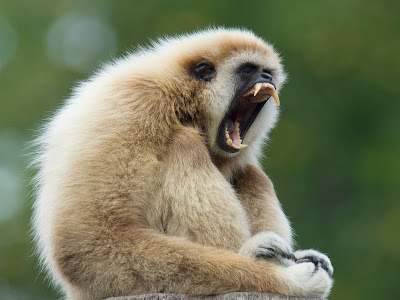
SOME AMAZING FACTS ABOUT THE GIBBON
G'day folks,
Gibbons are the gymnasts of the animal kingdom, bridging gaps of over 10 metres when brachiating. Don't forget to check out the video at the bottom of this post.
Quick FactsType: MammalDiet: Omnivore - fruit, leaves, insectsLifespan: Up to 25 yearsSize: 44-64cmHabitat: Tropical and sub tropical rain forestsRange: Northeastern India to southern China to BorneoScientific name: Hylobatidae
GIBBONSGibbons spend almost all of their time in the treetops of the rainforest. They even sleep there, resting in the forks of branches.Their dramatic form of locomotion, called brachiating, can move gibbons through the jungle at up to 35 miles (56 kilometers) an hour, bridging gaps as wide as 50 feet (15 metres) with a single swinging leap.Because they are not able to swim, different types of gibbons are isolated in different areas by large rivers.When gibbons walk, whether along branches or in the rare instances when they descend to the ground, they often do so on two feet, throwing their arms above their head for balance.They are the most bipedal of all non-human primates and are often studied for clues to what evolutionary pressures may have led to humans walking.There are 15 recognized species of gibbons ranging from Northeastern India to Southern China to Borneo.Gibbons are all tailless and their long coats vary from cream to brown to black. Many have white markings on their faces, hands, and feet.
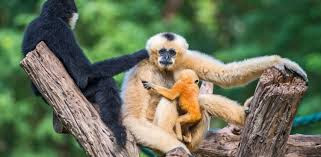
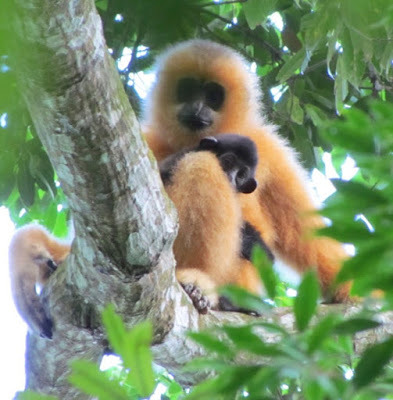
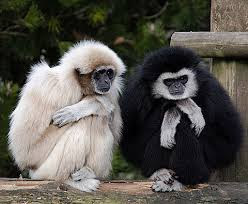 Gibbons are one of only a few species of primates that mate for life.The female gestation period lasts about 7 months and she will usually give birth to one offspring at a time.Young gibbons will stay with their parents in a family unit until they are old enough to venture off on their own and start their own family.Mated pairs, and even whole families, will sing long, complex songs together. Some species have even adapted large throat pouches to amplify their calls.They are most often heard in the early morning and may go on for half an hour or more. This morning ritual is usually initiated by the female, who is the head of the family group. Males and females have different calls.These iconic tree dwellers are among the most threatened primates on Earth. Their habitat is disappearing at a rapid rate, and they are often captured and sold as pets or killed for use in traditional medicines. All but one species of gibbon is listed as endangered or critically endangered.
Gibbons are one of only a few species of primates that mate for life.The female gestation period lasts about 7 months and she will usually give birth to one offspring at a time.Young gibbons will stay with their parents in a family unit until they are old enough to venture off on their own and start their own family.Mated pairs, and even whole families, will sing long, complex songs together. Some species have even adapted large throat pouches to amplify their calls.They are most often heard in the early morning and may go on for half an hour or more. This morning ritual is usually initiated by the female, who is the head of the family group. Males and females have different calls.These iconic tree dwellers are among the most threatened primates on Earth. Their habitat is disappearing at a rapid rate, and they are often captured and sold as pets or killed for use in traditional medicines. All but one species of gibbon is listed as endangered or critically endangered.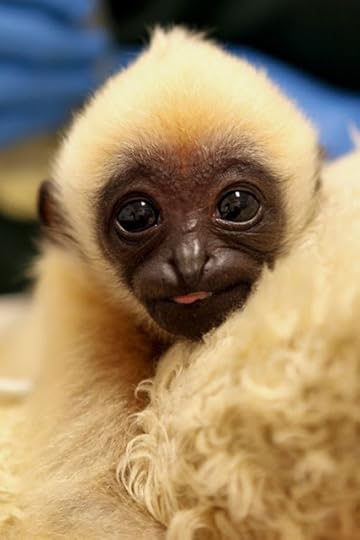

YOUTUBE VIDEO
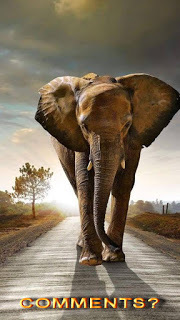
Clancy's comment: Wow, they are so agile ... And cute.
I'm ...
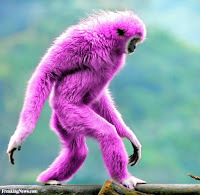

Published on August 21, 2018 14:42
August 20, 2018
21 August 2018 - GOTTFRIED KRUEGER’S MANSION IN NEW JERSEY IN DECAY
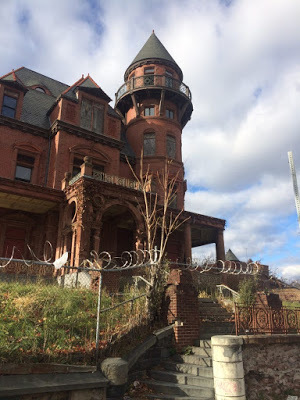
GOTTFRIED KRUEGER’S MANSION IN NEW JERSEY IN DECAY
G'day folks,
This is a sad story of neglect.
The once ornate staircase that leads to the crumbling mansion, is cracked and falling apart. The old, sculpted gardens have been over run with weeds, surrounded by fences of razor sharp barbed wire. Its once grand spires and turrets overlook a landscape of forbidding housing projects and the desolate lots of one of America’s most notorious and violent cities. We are standing outside the imposing, former home of Gottfried Krueger, once one of the grandest mansions to be found in Newark, New Jersey. But today, it lies abandoned, slowly decaying like a latter day Manderlay.

Gottfried Krueger was an immigrant from Germany, who made his fortune brewing beer. As the millions of immigrants flowed from Europe into America, mostly through Ellis Island, the demand for old English style ales was replaced with a demand for lighter, European lagers. Krueger was one of the many, wildly successful brewers that flourished meeting that demand. His beer was the first in America to be sold in cans, and by 1875, Krueger was producing over 25,000 barrels a year.

With his new found wealth, Krueger decided to build a grandiose, opulent mansion on what is today the corner of Dr. Martin Luther King Jr. Boulevard and Court Street. Back then the boulevard was known as High Street, a two mile long grand avenue, that wouldn’t have looked out of place in Haussmann’s Paris. Grand homes made of marble and granite graced a wide boulevard lined with graceful oak trees, that flowed like a river of wealth through Newark, itself a blossoming city, thriving on booming industry that followed the North’s victory in the Civil War.

But of all the mansions on High Street, none were as luxurious as the Krueger home. It had forty rooms, the first privately owned elevator in New Jersey. Archival photographs show the mansion’s opulent Louis XIV interior, its stained glass windows, and leather embossed walls glittering with mother-of-pearl wainscoting.
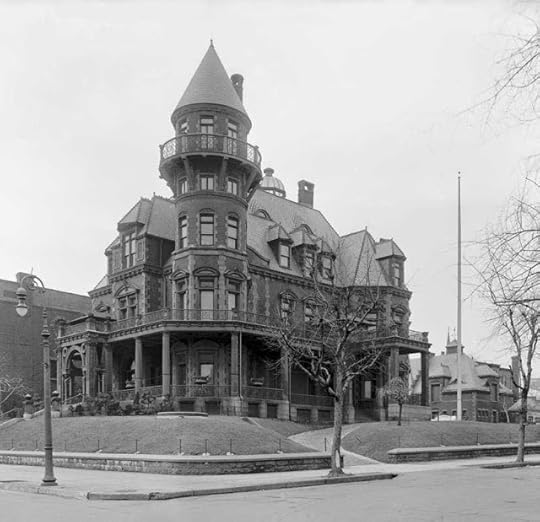
Five stories high, it was topped with a copper domed turret, that dominated the skyline. Its medieval spire would have been at home atop a castle from Kruger’s native Rhineland.

But business would eventually come to a halt for Krueger family. Faced with the twin perils of anti-German sentiment during World War I, and Prohibition, Krueger Beer would swiftly disappear from the hotel bars and beer halls of the North East.
The mansion was sold in 1926 to a fraternal society, the Newark Scottish Rites for $100,000. But the grand manse would grow in stature; the masonic society adding a 700 seat, lavish auditorium onto the house.
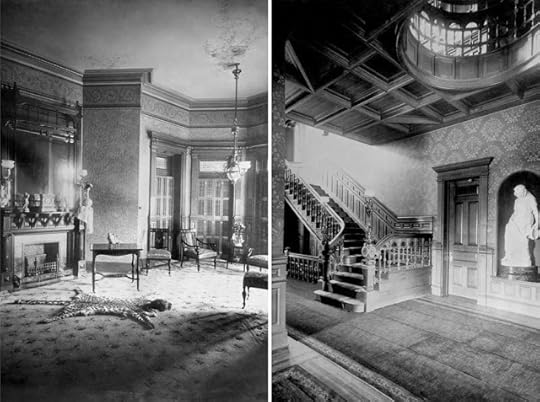
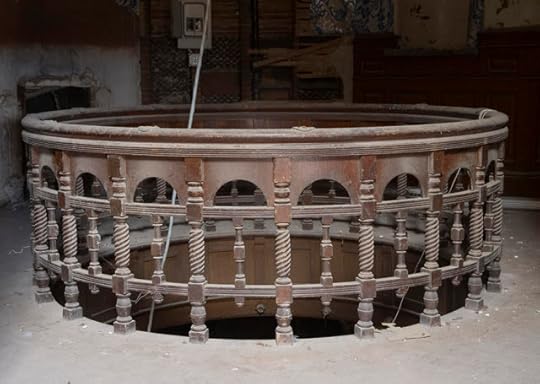
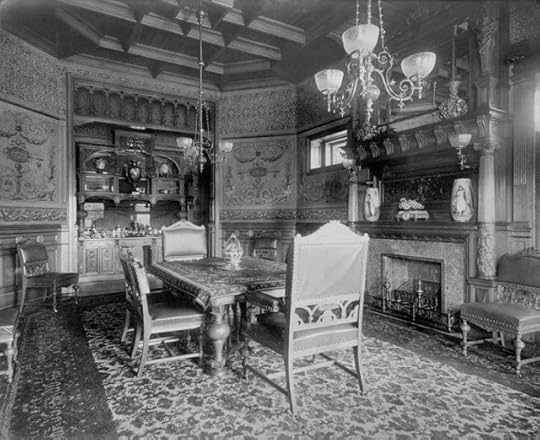
In 1958, Louise Scott, owner of a beauty school, purchased the mansion. She ran the school out of the lower floors, whilst she lived in the rooms above. Scott’s school thrived, and she is thought to be the first female African-American millionaire in New Jersey.
But when Scott died in 1982, the imposing mansion passed to the City of Newark, where it has laid abandoned ever since.
In many ways, the fate of the Krueger-Scott mansion mirrors the declining fortunes of Newark itself. Once a thriving, industrial city, the gradual loss of its manufacturing bedrock saw the city swiftly deteriorate into one of America’s most impoverished and violent cities. Rampant unemployment and crime came to a bloody head in 1967 with riots that brutally descended into all out street war, with twenty six people killed.
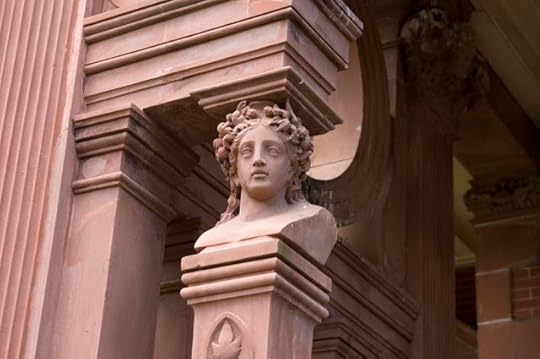

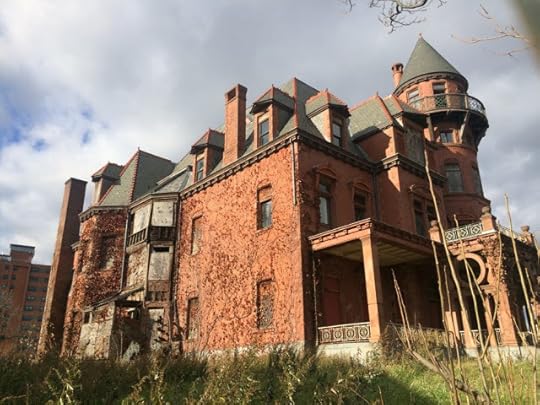
As more and more professional and working classes fled the city, an onslaught of drugs, crime, and one of the highest murder rates in the US saw forbidding housing projects replacing the many grand Victorian town houses of the past.
The Krueger mansion however was slowly allowed to crumble to pieces. Today it lies vacant, its once lavish interiors, ravaged by looters and vandals.
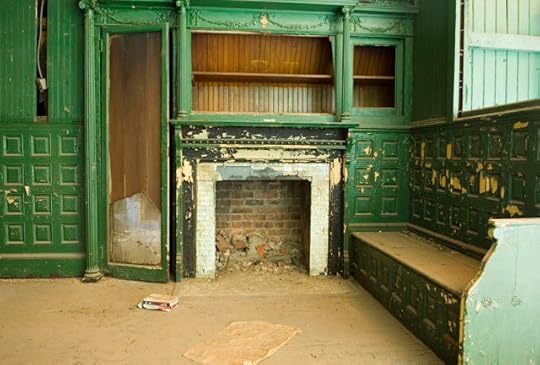

Ambitious plans to turn the empty mansion into a cultural centre celebrating Newark’s African-American heritage came to nothing, despite millions being spent on shoring up the decaying building. Eventually, the City Council, fighting a desperate war on poverty and crime, refused to spend any more money on the project.
Ever since, perhaps the most beautiful mansion ever built in New Jersey has gradually fallen apart, being slowly reclaimed by nature. Today it rests as a silent sentinel on hilltop, over looking a city that has shared its same sad fate.

Clancy's comment: What a bloody waste.
I'm ...


Published on August 20, 2018 15:05
August 19, 2018
20 August 2018 - JUNE 'JOE' BOYD - GUEST AUTHOR
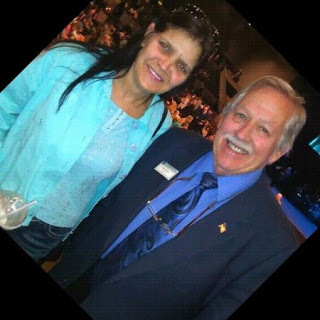
JUNE 'JOE' BOYD - GUEST AUTHOR -
G'day folks,
Today, I interview a man from the USA who writes inspiring stuff.
Welcome, Joe ...
1. Tell us about yourself and your writing journey?
Hi I’m Joe I’m 54 yrs.old I’m from Worthington a small town in Indiana. I have 3 children and 3 granddaughters I’ve been writing since the age of 6 yrs. I wrote a poem I took it to my mom showed it to her then she showed my grandma that next Sunday it was in the church bulletin yes it embarrassed the heck out of me. But when I showed my mom I had told her I wrote it for Willie Nelson to put to music and sing it for me all these years later and I’ve never met him .That poem is in my book “A Spiritual Awakening . 2. When and how did you become a writer?
I guess I became a writer 5 years ago when I got my first book "A Spiritual Awakening” out but I’ve been writings since I was 6 yrs. Old and the How not sure it just happens 3. What type of preparation do you do for a manuscript? Do you plan everything first or just shoot from the hips?
I don’t ever really prepare myself for manuscripts I just do it.
4.What do you enjoy most about being a writer? I guess the satisfaction after finishing a book . 5. What is the hardest thing about being a writer?
Actually I don’t find anything about it hard it’s just something that I always do I think if it was that hard I wouldn’t be able to do it. 6. What were you in your past life, before you became a writer?
I don’t know I’ve done it my whole life, I can’t imagine anything else but a writer.
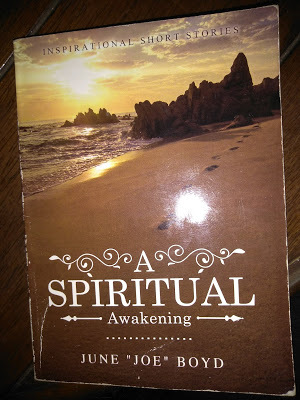
7. What is your greatest writing achievement?
I would say getting my first book out
8. What are you working on at the moment?
I’m working on my action book my third A Spiritual Awakening ,and whatever comes to mind when I wake up in the morning also I’m writing to biographies of two champion boxers
9.What inspires you?
Talking to other authors someone who is in the writing world
11.Do you have any tips for new writers?
Keep the faith and never give up on your dreams
12.Do you suffer from writers block?
So far that’s never been a problem since I’ve been writing my whole life let’s hope that never happens 13.Do you have a preferred writing schedule?
No I just write when I can
14. Do you have a preferred writing place?
Not really in Arizona I use to go up on a mountain and white I loved it there and peaceful
15. What is your greatest joy in writing?
That would be the completion of what I’m working on 16.Who is your favorite author? Why?
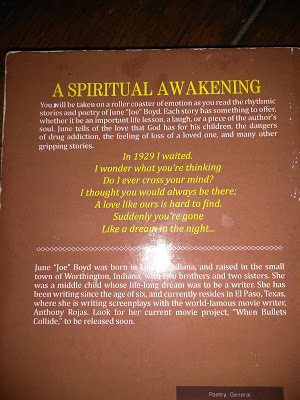
17. What was the greatest compliment you received from a reader?
That they thought my stories pulled you in as if they were there
18. What’s the worse compliment you got from a reader? I’ve never had a bad review on any of my stories which it’s an inspirational book maybe I don’t know.
19. Writers are sometimes influenced by things that happened in their own lives are you?
21.Did you have your book/books professionally edited before publication?
Well my publishers do all the editing so I guess that’s professionally 22. Describe your perfect day.
When I finish something I’ve started would be my perfect day 23. If you were stuck on a desert island with one person who would that be?
Willie Nelson hands down been in love with him since I was 5 yrs. old
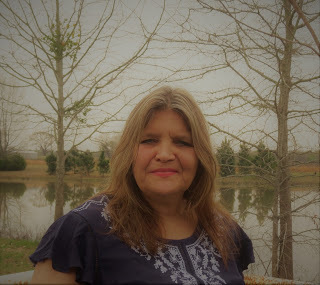
24. What are your plans for the future?
My plans are to get all my books out and making the best sellers list, keep on writing and come up with new stories
25. What are your views on book trailers? Do they sell books?
I believe that it’s very good marketing and it could only help the sales not hurt it in anyway and marketing is a huge factor in selling your books 27. Do you see yourself in any of your characters?
I guess you could say that I feel when I’m writing I am every character I live the story 28. Does the publishing industry frustrate you?
Yes in a way especially when you need to talk to them it’s hard to get them to answer their phone or call you back what isn’t of importance to them it is to me 29. Do you ever think of quitting?
No never I don’t think my mind would let me I’ve have new things in my head everyday 30. What was your favorite manuscript to write?
I guess that would be my first one A Spiritual Awakening
31. How would you describe success?
When you get to the point where your books are making money not costing money

32. What should readers walk away from your books knowing?
That it’s a life changer, and they are inspired
33. Would you like to have your books made into movies?
Of course who wouldn’t?
34. How much thought goes into a book cover?
Actually quite a bit the cover is a very important part of books The saying never judge a book by its cover well they do when I see books that’s the first thing I look at 35.What is your ultimate dream?
For all my books to be on the best sellers list and some into movies
36. Writing is one thing but marketing you your books your brand? Any thoughts?
Like I said before market plays a huge part in your sales of books if you don’t market them you won’t have too many sells
37. Are your books self-published?
No I have contracts for my publishers to do that part
38. Describe yourself in five words.
Persistent,honest,loyal,caring, busy 39. What pisses you off most?
When someone reads my poems or stories wrong and butchers my meaning of it
40. What is the title of the last book you read?
I don’t read very often so probably The Green Mile

41. What would be the last sentence you would write?
The End . Written by: Joe Boyd Or To be continued
42. What would make you happier than you are now?
To have these books done and out of my head to make room for more
43. Anything you would like to add?
I also write music and am working on getting my music out there. Thank you for inviting me to your blog have a blessed day Joe

BOOKS

Clancy's comment: Thank you, Joe. Best wishes with your book sales. Keep writing.
I'm ...


Published on August 19, 2018 15:27
August 18, 2018
19 August 2018 - AMAZING NATURE

AMAZING NATURE
G'day folks,
I'm always interested in photographs taken by other photographers. Some of these are brilliant. They make you want to be there ...



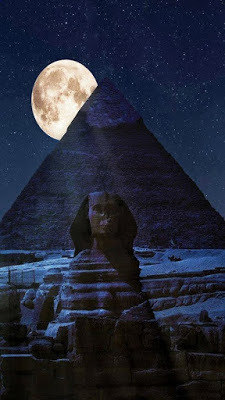
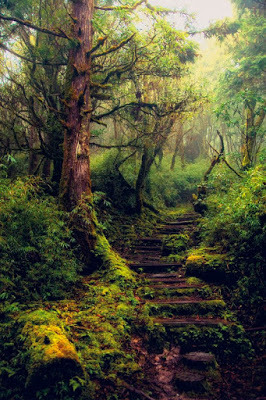





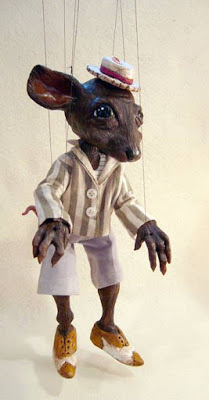

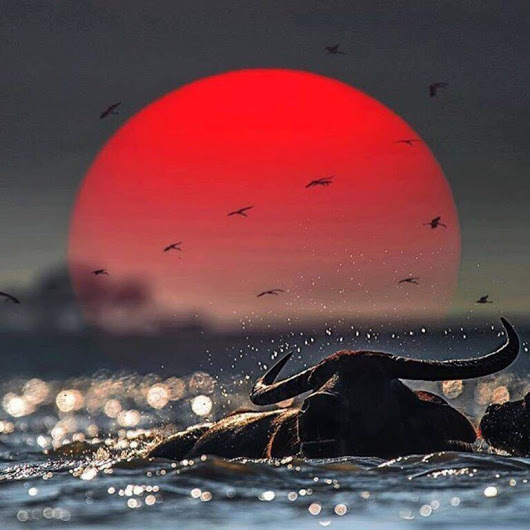
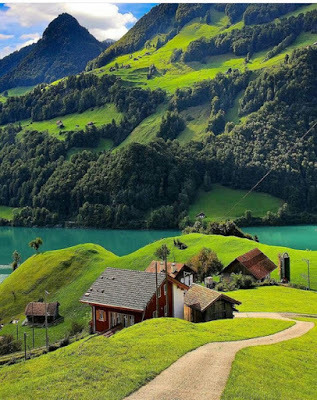
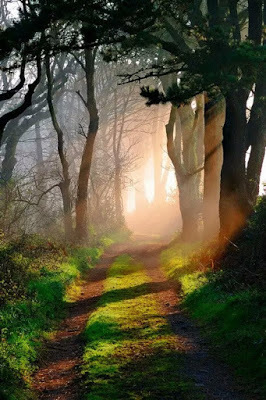


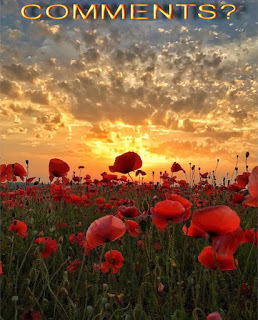
Clancy's comment: Awesome, eh?
I'm ...


Published on August 18, 2018 16:01
August 17, 2018
18 August 2018 - SOME AMAZING FACTS ABOUT SIR DAVID ATTENBOROUGH
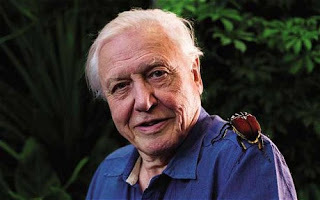
SOME AMAZING FACTS ABOUT SIR DAVID ATTENBOROUGH
G'day folks,
Welcome to some interesting facts about a man who is known around the world. I admire him greatly. He has entertained and enlightened me for many years, and he is probably the most difficult person on earth to replace.

1. Sir David Attenborough was born on 8 May, 1926, in Isleworth, West London
The same year as Queen Elizabeth II!
2. He was raised on the campus of University College, Leicester
Now the University of Leicester, where his dad was principal.
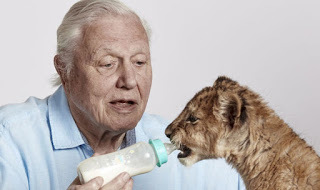
3. Sir David doesn’t count himself as an animal ‘lover’ But instead, says he has always been fascinated by them.
4. He’s thrifty!
At 11 years old he struck a deal selling newts to University College, Leicester for 3d (3 pence) each. The newts only came from a pond 5m away from the university’s zoology department!
5. He is the only person to have won BAFTAs for programmes in black and white, colour, HD, and 3D. 6. He doesn’t own a car as he never passed his driving test
He’s also not keen on sending emails, and prefers receiving letters by fax or post.
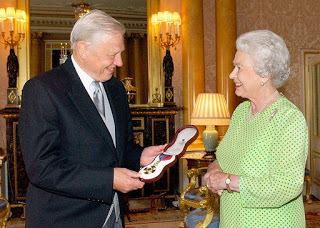
7. During World War II his parents adopted two Jewish refugee girls from Europe.
8. There’s only one animal Sir David doesn’t like…Rats!
9. Sir David was rejected from the first job he ever applied for at the BBC
The position of radio talk producer.
10. In 1947 he spent two years serving in the Royal Navy
Based in North Wales and the Firth of Forth.
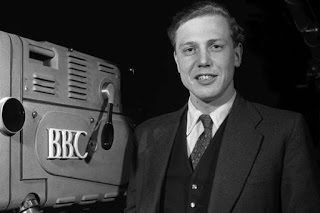
11. When Sir David got his first job in television, he didn’t even own a TV
Like most British people at the time!
12. His first programme, called Coelacanth, looked at the rediscovery of the coelacanth
– a prehistoric fish.
13. Sir David has more than ten plants and animals named after him Such as the Nepenthes attenboroughii – a giant carnivorous plant that devours animals as large as rats – and the UK’s new polar research vessel, RRS Sir David Attenborough.

14. In 1985 he received a knighthood
Granting him the title of Sir David Attenborough.
15. He’s thought to be one of the most well-travelled people on the planet For The Life of Birds documentary, he travelled a whopping 256,000 miles – that”s the same as travelling around the world ten times!
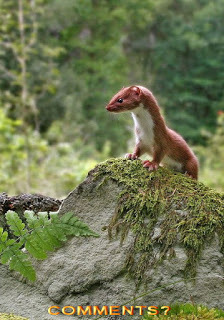
Clancy's comment: What can I say?
I'm ...
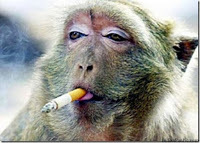

Published on August 17, 2018 14:54
August 16, 2018
17 August 2018 - WONDERFUL MOVING PICTURES

WONDERFUL MOVING PICTURES
G'day folks,
Welcome to some extraordinary moving pictures created by clever people.
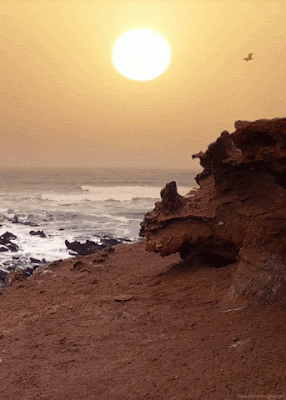
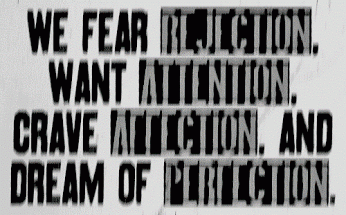

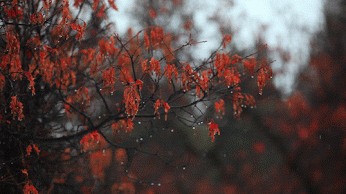

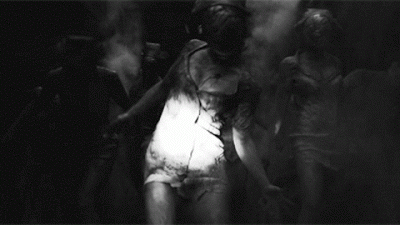

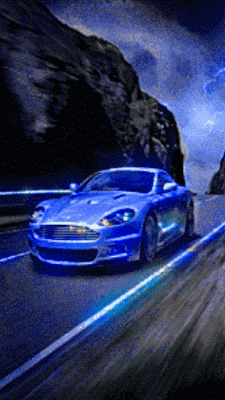
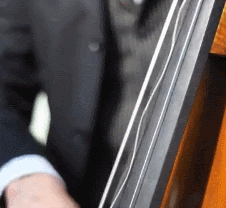


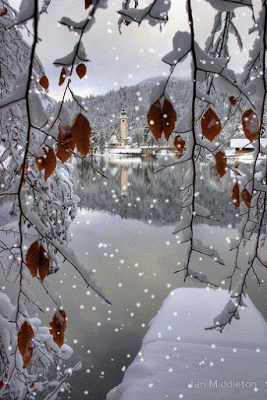
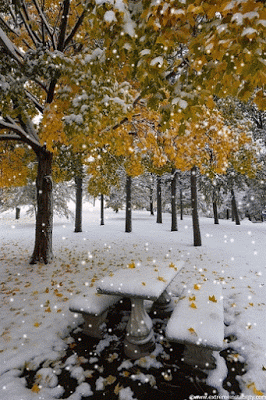
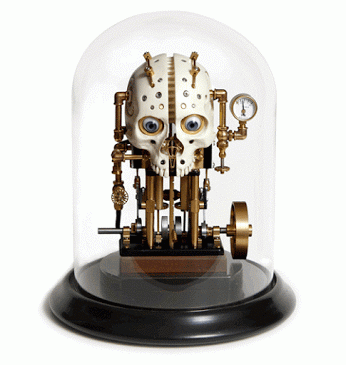
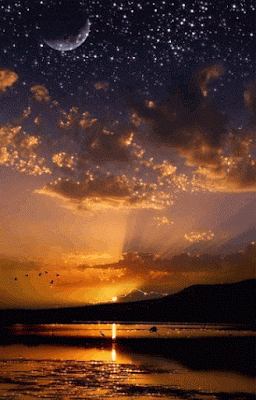
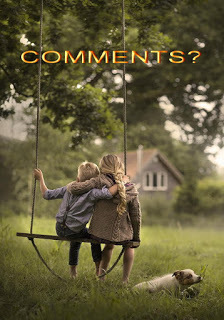
Clancy's comment: Love the little kid and the dog.
I'm ...


Published on August 16, 2018 13:33
August 15, 2018
16 August 2018 - SOME FACTS ABOUT THE CHIMPANZEE
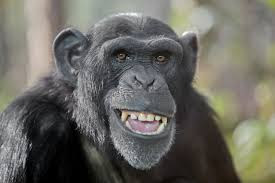
SOME FACTS ABOUT THE CHIMPANZEE
G'day folks,
Welcome to some facts about a creature that is very interesting to observe.
FACTS
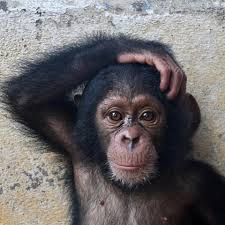
Chimpanzees are black, but older individuals may have a grey back. Both genders often have short white beards. The ears are prominent. Infants have a white tail tuft and pink to brown facial skin, which darkens by adulthood.
Chimpanzees have been shown to have their own individual personalities.Chimpanzees behave in a way indicationg that they feel empathy.Chimpanzees live in fluid social groups consisting of a core of multiple females and dominant related males, whom are highly territorial and will routinely patrol their home boundaries. Females tend to live a more solitary life than the males, often choosing to spend much of their time alone with their offspring.Chimpanzee infants are completely dependent on their mothers until about five years of age. When males are between the ages of 8-12 years, or adolescence, they will increase their independence and spend more time in the company of adult males. Females tend to remain close to their mothers during adolescence, becoming mature at age 11 but only beginning to breed at age 13-14. On average females will have about three offspring during their lifetime.Chimpanzees travel mostly on the ground but will mostly feed in trees during the day and make a new nest every night in the forest canopy to sleep.Chimpanzees are classified as endangered in the wild. Aside from habitat loss they are hunted for bushmeat and infants taken for sale into the pet trade.Chimpanzees have many different vocalizations from soft grunts and lip smacks to alarm barks and screams. One of the most notable vocalizations is the pant hoot used in situations of increasing social excitement. Chimpanzees are also capable of learning basic human sign language.Chimpanzees have opposable thumbs and toes that allow for grasping, climbing, and object manipulation. Chimpanzees are very dexterous and are able to manipulate objects in their environment in order to fashion and use tools. These tools are usually used to obtain food sources. Sticks are used for termite fishing and ant dipping, leaf sponges to soak up water and, in West Africa, chimpanzees use specially chosen rocks to crack hard palm nuts, a behaviour that can take many years to perfect. Baby female chimps were recently discovered playing with sticks like human children play with dolls.Their diet varies seasonally consisting mainly of fruit (~50-75%), but also leaves (~12-45%), flowers (~1-18%), seeds (~1-11%) and animal prey (~1-5%) such as grubs, termites, ants, wasps, birds and mammals including bush-pigs, duikers, rodents and even other primates.In the Ivory Coast chimpanzees will hunt together cooperatively to catch red colobus monkeys, the meat is much prized and its subsequent sharing strengthens male alliances and familial bonds.
Similarities between Humans and Chimpanzees
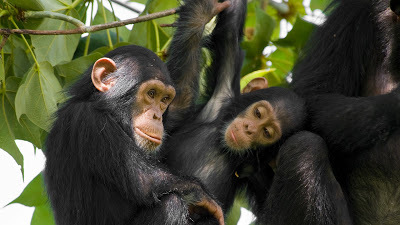
We, Homo sapiens, share 98.4% of our DNA with chimpanzees.Chimpanzees have the same bones and muscles as humans with differences only in form (e.g. their arms are longer than their legs). Adapted for quadrupedal movement and movement through the trees, chimpanzees have robust bodies and powerful arms. Because of their dense bones and muscle tissue, the upper body strength of a mature chimpanzee is 8-10 times that than that of humansIn response to our greater understanding of our close similarity to great apes in terms of their capacity for self recognition and their innate intelligence, a movement called The Great Ape Project, calls for certain civil rights to be granted to all great apes, including the right to life, liberty and freedom from torture.Despite our increasing understanding of the significant similarity between humans and chimpanzees, humans continue to use chimpanzees in experiments, including experiments which cause them significant pain and suffering.
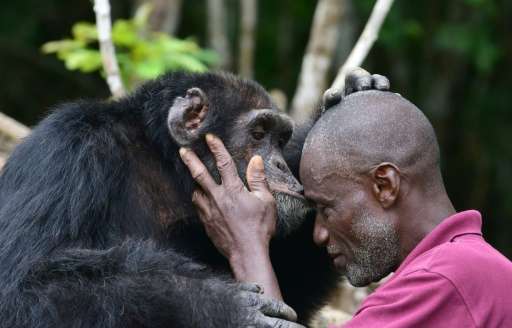
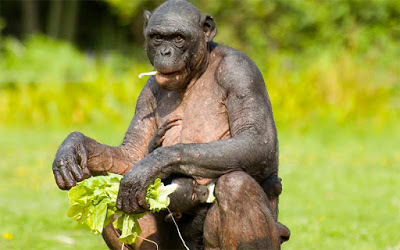


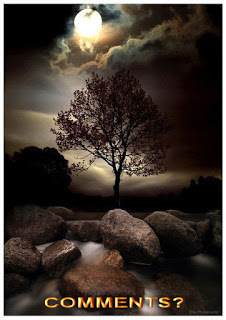
Clancy's comment: A very smart creature.
I'm ...

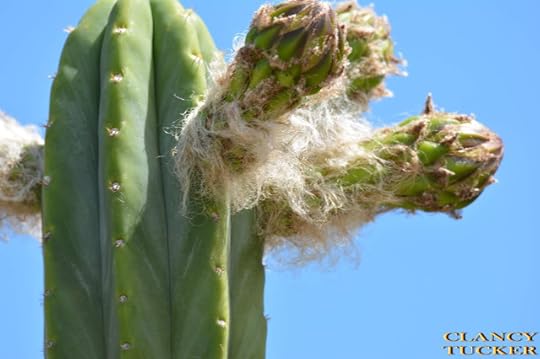
Published on August 15, 2018 18:03
August 14, 2018
15 August 2018 - YAGAN'S FAMOUS SKULL
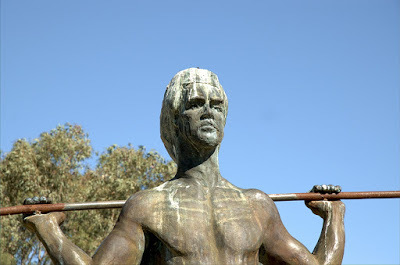
YAGAN'S FAMOUS SKULL
G'day folks, Yagan was an Indigenous Australian warrior from the Noongar people. He played a key part in early resistance to British colonial settlement and rule in the area surrounding what is now Perth, Western Australia.
It is tragic that it has taken a struggle over the skull of Noongar warrior Yagan to bring him to the attention of the Australian public, for during his life he was one of the most respected Aboriginal resistance leaders.
Yagan was of the Nyungar people from south-west Western Australia, where Perth, Fremantle and Albany are now situated.
When Captain James Stirling established a colony on the Swan River in 1829, he proclaimed the Nyungar British subjects. Early reports show that the local people and the European settlers cooperated well at first, trading fish and game for bread and flour.
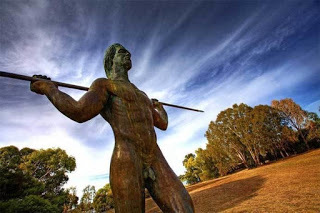
When the clashes did come, they were over land and resources. The Nyungar annual practice of burning the land was mistakenly seen as an act of hostility by the settlers, and the Nyungar saw the settlers' livestock as fair game to replace the dwindling stocks of native animals, which the settlers were hunting or displacing.
In 1831, a Nyungar was shot while taking potatoes from a settler's garden. Yagan was amongst the group that returned to seek revenge. A settler, Enion Entwhistle, was speared in the attack, but his two sons escaped to report the incident.
In June 1832, another man, named Gaze, was killed by Nyungar warriors. Yagan was named one of the leaders responsible and officially declared an outlaw. A reward of £320 was placed on his head.
Attacks and reprisal attacks grew. ThePerth Gazette wrote: "The reckless daring of this desperado, who sets his life at a pin's fee, is being the subject of general observation, and we firmly believe for the most trivial offence, even with a loaded musket at his breast, he would take the life of any man who provoked him." Efforts to capture Yagan were increased, and later in 1832 he was captured.

Yagan was described as over six feet (1.8 metres) tall and possessing "a dignified bearing ... head and shoulders above his fellows, in mind as well as in body, and though a subject of terror to the white people, he yet commanded their admiration". The contradictory views of Yagan by the settlers can be seen in reports of the time that described him as either courteous and hospitable or very menacing.
Yagan was saved from execution by a settler, Robert Lyon, who argued that Yagan should be treated as a prisoner of war rather than a criminal. It is tragic that this never became a precedent for later indigenous resistance fighters.
Yagan was sentenced to exile on a rocky island off Fremantle, Carnac, where Lyon was to be responsible for "civilising" him. Lyon sympathised greatly with Yagan's fight to protect his people and his land, and he published many articles about him. Yagan did not stay in exile long, however. After six weeks on Carnac, he and his Nyungar companions stole a small boat and returned to the mainland.
Yagan was soon being pursued by the military again, after taking part in a pay-back slaying of two men who had shot a Nyungar without provocation. The reward on his head was increased to £330, but the armed patrols that scoured the countryside had no success.
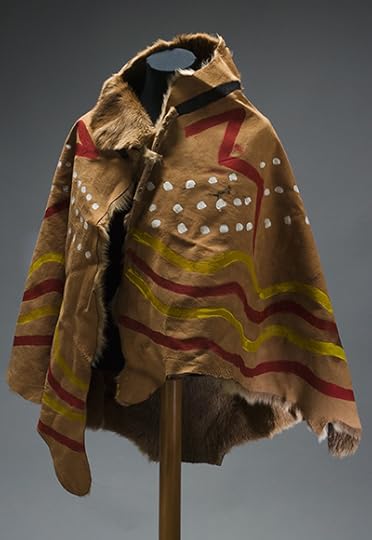
The growing conflict between muskets and spears took a heavy toll on the Nyungar people. Yagan's brother, Domjuim, was killed and decapitated, and his father, Midgegooroo, was captured, tried and shot. Tensions in the colony were high, with rumours that hundreds of well-armed Nyungar were mobbing to attack outlying areas.
Yagan next appeared at the farm of George Moore and demanded to know what had happened to his father. Moore wrote in his diary: "Yagan stepped forward, and leaning his left hand on my shoulder, while he gesticulated with the right, delivered a short of recitative, looking earnestly at my face. I regret that I could not understand it; I thought from the tone and manner that the purport was this: 'You came to our country; you have driven us from our haunts and disturbed us in our occupations. As we walk in our country we are fired upon by the white men. Why should the white men treat us so?'"
On July 11, 1833, with a group of Nyungar, Yagan approached two young shepherds he knew, James and William Keats, and asked them for flour. Recognising Yagan and keen for the reward, William, when he saw the chance, levelled his musket at Yagan behind his back and shot him dead. Both brothers then fled, but William was caught and speared to death.

James soon returned to the scene with an armed party. They found the body of William and, some distance away, the bodies of Yagan and another Nyungar, Heegan. Heegan was still alive and was shot in the head. Yagan's head was cut off and his tribal markings skinned off his back.
James Keats received the £330 reward, but the Perth Gazette criticised his actions as "a wild and treacherous act ... which it appears to us will annihilate the surest road to perfect amity — mutual confidence ... We are not vindicating the outlaw, but, we maintain, it is revolting to hear this lauded as a meritorious deed."
Nyungar resistance was to continue under leaders such as Calyute, south of Fremantle, and Weeip of the upper Swan group, until the Battle of Pinjarra in 1834, when troops slew up to 50 Nyungar warriors and forced a surrender.
Yagan's head was preserved by smoking in a hollow tree stump for several months and was then taken to England by one Ensign Robert Dale. It was described as having had the hair combed, possum fur string tied around the forehead and red and black cockatoo feathers added for show.
The head was presented to the Liverpool Royal Institute for exhibition. In January 1835, London's Literary Gazettenoted that phrenological examination had confirmed the "barbarous passions" of its owner when living.
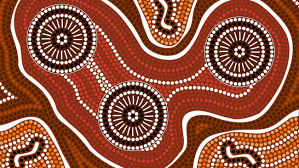
In 1894 the head was passed on to the Liverpool City Museum, where it was exhibited until 1964, it was buried in the Everton Cemetery.
Ken Colbung, the 66-year-old descendant of Yagan who was instrumental in finding the head and having it exhumed, said the spirit of Yagan would now be able to join the continuum and could perhaps live on in a new body. His fighting spirit and stance against injustice should at least live on in our history.

Clancy's comment: This man was probably Australia's first land rights activist, and paid a heavy price for so being.
I'm ...
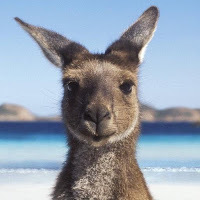

Published on August 14, 2018 15:15
August 13, 2018
14 August 2018 - WEIRD AND WONDERFUL STUFF
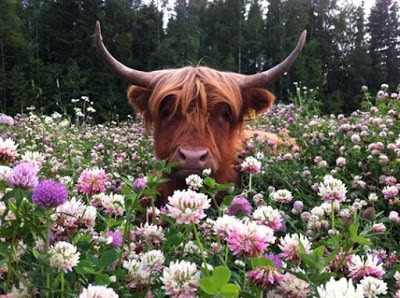
WEIRD AND WONDERFUL STUFF
G'day folks,
Welcome to some weird and wonderful stuff ...
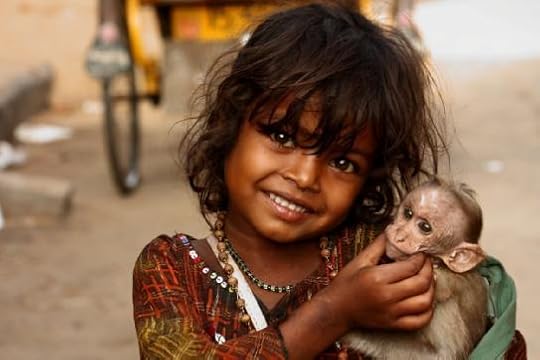

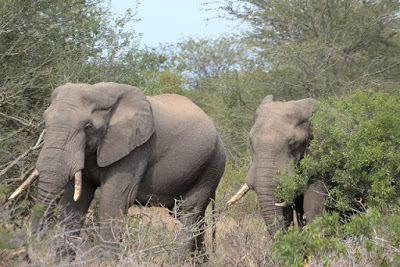




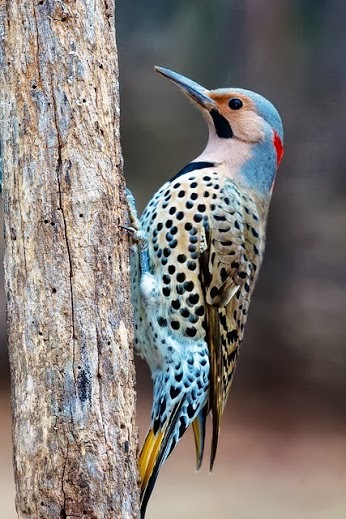





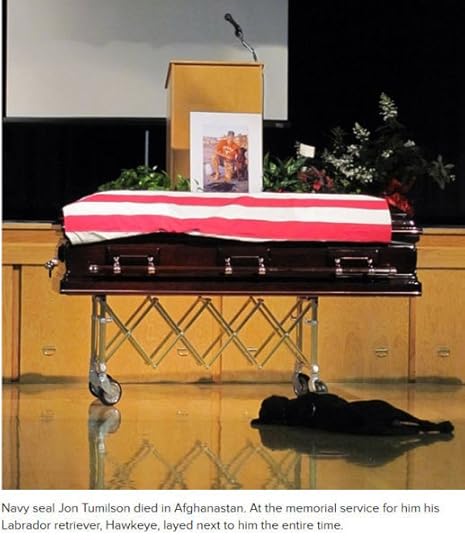

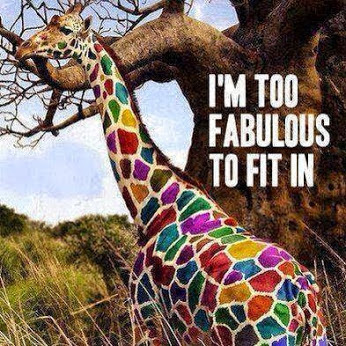

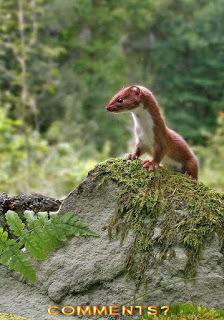
Clancy's comment: I love the young girl and the dog ... And the dog with his master at the funeral.
I'm ...


Published on August 13, 2018 13:38
August 12, 2018
13 August 2018 - INSPIRING QUOTES

INSPIRING QUOTES
G'day folks,
Yep, time for some more of those inspiring quotes.



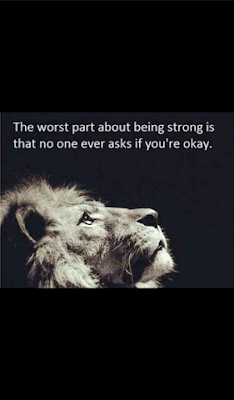











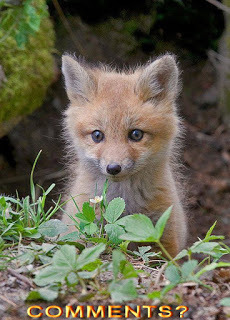
Clancy's comment: Yep, love the one about rich people being poor.
I'm ...


Published on August 12, 2018 14:44



